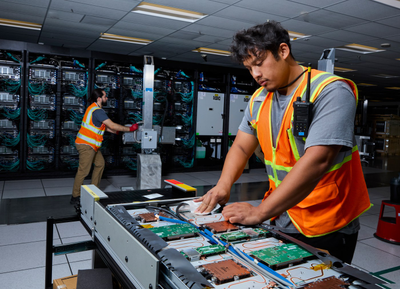
The Bay Area Wins Computing Crown with El Capitan Supercomputer
In a major breakthrough, the Lawrence Livermore National Laboratory (LLNL) in California has unveiled its new supercomputer, El Capitan. This behemoth of computing power has taken the top spot on the prestigious TOP500 list, pushing the previous champion, Summit, built for the Oak Ridge National Laboratory in Tennessee.
El Capitan's supremacy is no coincidence. Its brains live in refrigerator-sized units packed into 6,000 square feet of windowless floor space – equivalent to two tennis courts – inside Building 453, a nondescript tan structure protected by LLNL's notoriously strict security. A secret code guards its door, and at peak power, El Capitan draws an impressive 30 megawatts of electricity.
A Symphony of Power
This remarkable machine is a symphony of power, with long fiber-optic cables stretching across multiple football fields if laid end to end. Hewlett Packard Enterprise (HPE) contributed its networking technology called SlingShot, while AMD provided the special graphics processing chips that give El Capitan its edge.
Anna Maria Bailey, chief engineer of LLNL's High Performance Computing, notes that in supercomputing facilities, "you have to have the space, the power, the cooling, and you also have to have the structural integrity of the facility to support the infrastructure." El Capitan's seismically protected design ensures it can withstand even the most severe earthquakes.
The Key Role of El Cap
El Capitan's primary purpose is to support the testing of our aging nuclear system at LLNL, Los Alamos, and Sandia National Laboratories. This critical role involves running high-resolution 3D modeling and simulations that were previously too expensive or computationally too expensive to run on a regular basis.
"This one key advantage of El Capitan," says LLNL's Neely, "is that it offers us the ability to run those runs more commonplace." With its unparalleled power, El Capitan will accelerate research in non-classified fields such as earthquake prediction, wildfire modeling, and climate change simulations. The computer will also be used for groundbreaking research into gene behavior and disease modeling.
Racing Against Time
As other nations continue to pursue nuclear agendas, the Biden Administration's 2022 export controls on semiconductor chips have made El Capitan's key role even more crucial. Faced with escalating rivalry between the United States and China, LLNL's experts emphasize that their aging nuclear system cannot sit idle for decades and still be ready to spring into action at a moment's notice.
A New Era in Computing
Judy Hill, project leader of Computational Science at LLNL, is excited about what El Capitan will enable. "I cannot wait to see what El Capitan allows us to do," she says. With its sister machine Sierra, scientists can now tackle projects that were previously unimaginable.
The Future of Supercomputing
China may have powerful supercomputers not yet disclosed in public, but El Capitan stands as a shining example of the United States' commitment to innovation and leadership in this field. As the world faces pressing challenges like climate change, global pandemics, and nuclear threats, supercomputers will play an increasingly vital role.
In this new era of computing, LLNL's El Capitan stands at the forefront, a testament to human ingenuity and collaboration.